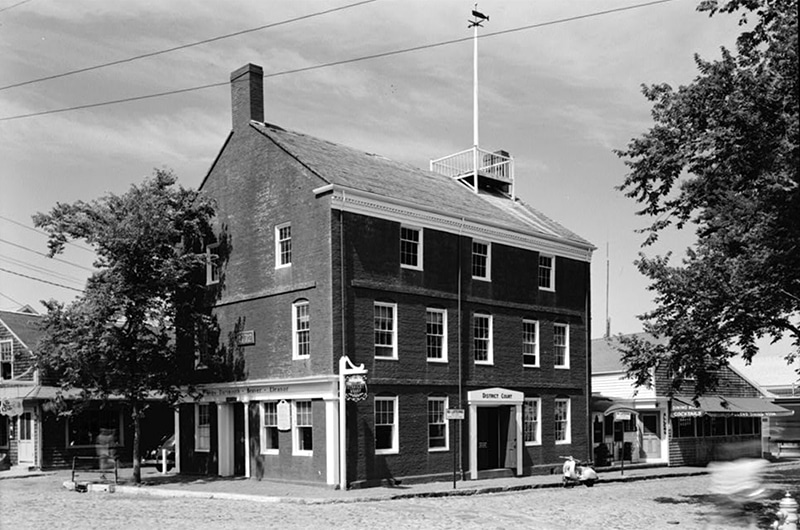~ by Amy Jenness ~

Rotch’s structure survives today and is the only 18th century brick building still standing on Nantucket. For 140 years it was the center of Nantucket business, first for captains of William Rotch & Sons ships and later as home base for the island’s customs house, weather bureau, district court and the Pacific Club, which began as an exclusive gathering of Nantucket’s storied ship captains. Born in 1734, William Rotch was a Nantucket Quaker and made his fortune as a ship owner and spermaceti candle manufacturer at a time when Nantucket was the third largest port in New England behind Boston and Salem.
Although he remained a pacifist, and pushed island leaders to keep Nantucket neutral during the American Revolution, Rotch and his ships were pulled into the conflict nonetheless.
In 1773 two vessels Rotch had chartered to the East India Company— the Dartmouth and the Beaver— were raided during the Boston Tea Party while they were docked on Rowe’s Wharf. Later, Rotch’s ship Bedford was the first vessel to fly the American flag as it sailed up the Thames into London in 1783. But the American Revolution was a disaster for Rotch’s whaling business. Both Britain and America refused to let Nantucket ships trade goods and mistrusted the islanders’ neutral stand.
In his memoir Rotch wrote, “From the year 1775 to the end of the war we were in continual embarrassments. Our vessels were captured by the English, and our small vessels and boats sent to the continent for provisions denied and sent back empty under pretense that we supplied the British, which was without the least foundation. Prohibitory laws were often made in consequence of these reports, unfounded as they were. By this inhuman conduct we were sometimes in danger of being starved.”
In 1779, Rotch was part of a town-appointed committee that appealed directly to the British commanders and got them to agree to stop attacking Nantucket ships. But Nantucket citizen and patriot, Thomas Jenkins, charged the committee with treason for going to a British port without permission. A joint committee of the Continental Congress House and Senate heard the complaint in 1780 and Rotch and his fellow committee members were not given full liberty until the war ended.
Three years later, William Rotch and Samuel Starbuck traveled to Philadelphia, PA and submitted a petition to the U.S. Congress seeking permission for Nantucket whaleships to sail unmolested by American ships fighting for independence. Congress did not take up the petition until 1784 and by that time Nantucket’s economy had been hobbled by the war. In its report, the Congressional committee found “that the inhabitants of Nantucket have been and still continue in a very distressed state owing to the destruction of their whale fishery.”
It recommended that Nantucket ships be “provided with a Certificate from the Selectmen of said Island that she is bona fide the property of the inhabitants of said Island and provided further that nothing be found on board her but the necessary whaling utensils provisions for the voyage and the product of the fish taken therein.”
When the war ended Rotch transferred his whaling operations to France. In time Rotch’s son moved it to Wales. William Rotch returned to America in 1795 and settled in New Bedford where he continued to own whaleships until he died in 1828.
The U.S. Customs Service, established by the First Congress in 1789, is the oldest federal agency. It assesses and collects duties and taxes on imported goods, controls carriers of imports and exports, and combats smuggling and revenue fraud. On Nantucket, the first customs office was opened in 1791. Most of the customs documents between 1791 and 1846, which include crew lists, bills of sale, coasting license bonds, and vessel registers have been lost either to fire or by deterioration.
Nantucket’s customs office took up residence in Rotch’s warehouse. Even though the American Revolution and the War of 1812 devastated the island’s whaling industry, Nantucketers went back to see at the conclusion of each conflict. By 1830, Nantucket had 140 sailing craft doing business, which included 73 ships, 20 schooners, 46 sloops and a steamer.
But the island’s prosperity at sea, hunting whales and seals and transporting goods all over the world, would not last. Fire wiped out much of the island’s downtown and wharves in 1846, shifting sands filled in the entrance to the harbor and made it impossible for large ships to enter, whaleship owners lost crewmembers and their ships to the California Gold Rush in 1849.
By the time the 19th century ended Nantucket’s dominance as a New England port was merely history and, although the customs agent went to work each day, there was nothing for him to do. In 1913 Obed G. Smith had been the collector of customs for ten years and had collected a total of 48 cents. One of President William Howard Taft’s last acts was to reorganize the US Customs Service and under the new plan Nantucket lost its historic institution in March of 1913.
Around that time the members of the Pacific Club purchased the building for $1,200. Founded by seven Nantucket whaling captains, the Pacific Club had used rooms on the first floor as a gathering spot for island mariners to meet, talk and play cribbage. By the time Nantucket’s last three surviving whaling captains died – Edward B Coffin (1911), William M Eldridge (1912) and Thaddeus DeFriez (1913) – the Pacific Club membership had opened up to include recreational mariners as well as commercial ones.
In the ensuing years the club leased portions of the building to island businesses and nonprofits as well as to the district court. Today, the Pacific Club is home to a store and ATM on the ground floor.
Amy Jenness is the author of On This Day In Nantucket History.